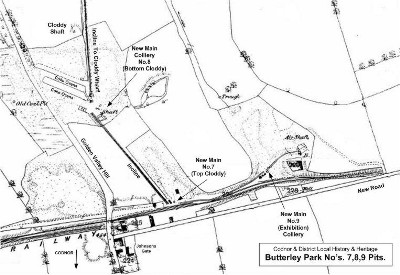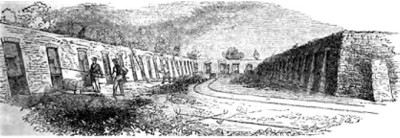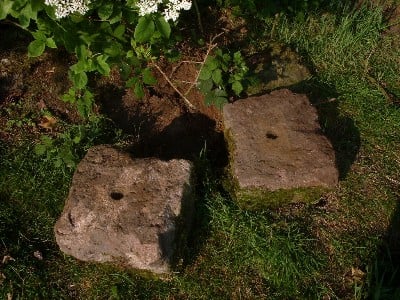
Cloddy, New Main, & Exhibition Pits.
(Butterley Park No's.7,8,9)
Ive have chosen to cover these three pits on this page because eventually they were all part of the Butterley company's New Main Colliery.
Fig.1 This Map from 1881 shows the layout of the pits that were on the righthand side of the road going down Golden Valley hill towards Golden Valley. Note the two incline tramways used for transporting the coal and Ironstone. These were both "self acting Inclines" meaning the full waggons travelling down the incline would pull up the empty waggons from the bottom of the hill using a cable around a pulley at the top of each incline.
Exhibition Pit (Butterley Park No.9)
Opened in 1851 and named after the Great Exhibition at Crystal Palace. It mined the Kilburn seam at 300yds deep and also connected to the Blackshale seams at New Main colliery. The Exhibition pit was not very successful because the Kilburn seam was much thinner than first thought. It was abandoned in 1871 but still kept open to act as air shafts for the New Main colliery. It finally closed altogether in 1881
Fig.2 All that remains of the Butterley Park No.8 New Main Colliery Engine House.
Top and Bottom Cloddy Pits.
These two pits were dug in 1843 and were located on the righthand side of the road on Golden Valley hill. Butterley Park No.7 ,locally known as "Top Cloddy" because it mined the Clod coal seam at 145 yds deep, was the upcast shaft. Butterley Park No.8 (Bottom Cloddy) was the down cast shaft at 158 yds deep to Clod coal seam.They also mined the Brownrake Ironstone seams.
New Main Colliery
Both pits together with the No.9 Exhibition pit became known as New Main Colliery with Mr Richard Strick as the first colliery Manager.
It will be noted that on the map at the top of this page can be seen two lines of Coke Ovens. These were built by the Butterley company to provide coke for their Ironworks.
Fig.3 This is a drawing of the Butterley Company Coke ovens at New Main Colliery in 1844 taken from a publication entitled "The Penny Magazine" by the "Society for the Diffusion of Useful Knowledge".
The magazine features an article called "A day at the Butterley Company" and part of it reads as follows.
"On ascending the inclined plane, a range of about a hundred coke-ovens is seen, lying somewhat in horse-shoe form. Each oven is a brick structure eight or ten feet high, having a flat roof with an opening at which to introduce the coal, and another opening in front at which to remove the coke. All being arranged contiguous, there is a railway running along the roofs of all of them, at a distance of two or three feet from the charging-holes. There is a colliery close to the ovens; so that the coal is no sooner drawn up to the mouth of the pit, than it is wheeled along the railway, and emptied into any one of the ovens. In these ovens the coal is kindled without access of air, and is deprived of its bituminous and more inflammable ingredients by the usual process of coking. When the coke is removed from the ovens, and ready to be taken away from the works, it is placed in carriages on the railway, and, by an ingenious arrangement of ropes, is allowed to descend the inclined plane to the canal by its own weight, drawing up at the same time a train of empty carriages to be refilled".
Fig.4 The Incline from New Main colliery down to the canal was layed on stone sleeper blocks. These blocks can still be found discarded by farmers at the edge of the field on the right going down Golden Valley hill.
The Derby Mercury newspaper reported the following mining accident on 24th January 1855
Inquests Before Mr Whiston Jun., Coroner.
On Wednesday the 10th inst., at Codnor Park, on the body of Thomas Radford, aged 51 years who's death took place the previous day in consequence of about five ton weight of bind falling upon him, whilst at work in the Exhibition coal pit, belonging to the Butterley company. The inquest was adjourned for the purpose of giving notice to the Government Inspector, who attended accordingly; and after a careful enquiry, it appeared that the fall of bind had taken place owing to the deceased having himself neglected to support it, after being told that it was in a dangerous state. The jury returned a verdict of "Accidental death".
The Sheffield and Rotherham Independent newspaper reported the following mining accident on 1st July 1881
COLLIERY FATALITY NEAR RIPLEY
Considerable excitement was caused in Ripley on Wednesday by the report that a fatal accident had occurred at the New Main Colliery, generally known as "Cloddy Pits" near Ripley and Codnor, belonging to the Butterley Company. Two of the workmen were missing, and men were sent in search of them. They were subsequently found in the pit workings quiet dead, death having apparently resulted from suffocation. They were not brought up to the surface of the pit until about five o'clock yesterday morning. Hundreds of people had assembled to witness the sad sight. The bodies were removed to the New Inn, Codnor, to await the Inquest. The names of the unfortunate men are Joseph Grainger, aged 52 years, widower, and Samuel Grainger, aged 40 years, married with family. They are stated to be second cousins, and both resided at Codnor.
The official accident report shows that both men were in the Butterley Park No.7 New Main pit ( Top Cloddy) and had been exploring an old heading, having left their safety lamps behind, went forward and were suffocated by gas.
Joseph Grainger (spelt Granger in the 1881 Census), already a widower, lived on Nottingham Road with his three sons Joseph, James and Frank and daughter Hannah.
Samuel Grainger (Granger) lived on Mill Lane with his wife Rachel and sons Herbert and Frederick and Daughter Bertha.
Information for this page was obtained from the following sources.
The Heritage of Codnor & Loscoe, by Fred S Thorpe 1990
The Coal Mining History Resource Centre, Picks Publishing & Ian Winstanley
A History of Mining in the Heanor Area, Heanor & District Local History Society publication 1993
The Penny Magazine, published by the Society for the Diffusion of Useful Knowledge 1844
The Sheffield and Rotherham Independent, 1st July 1881




